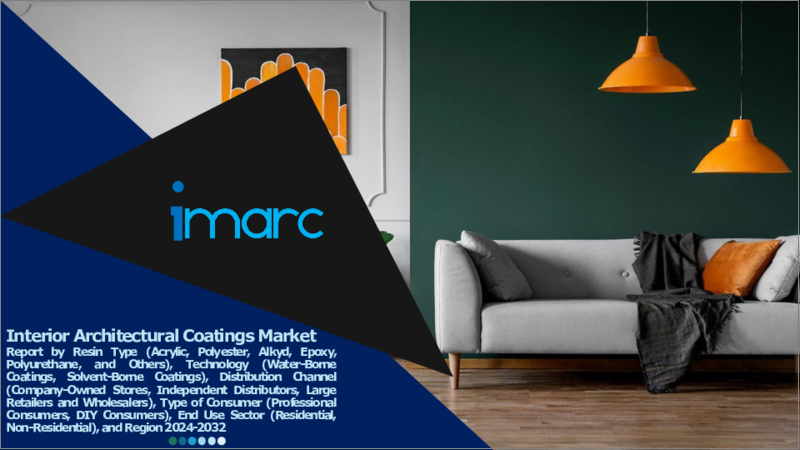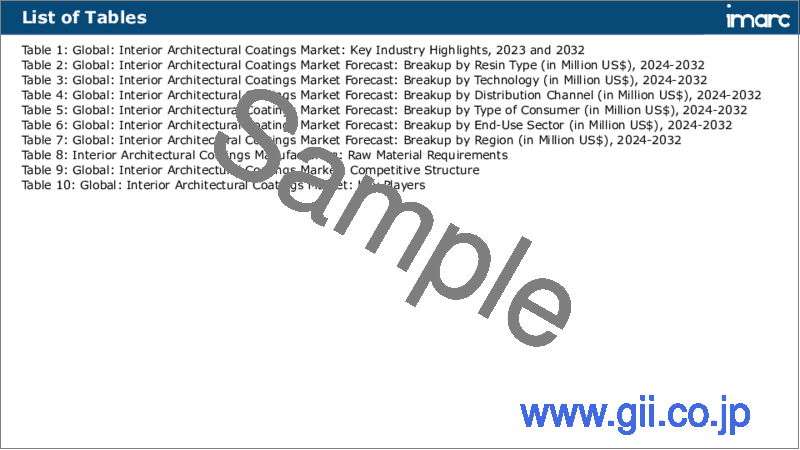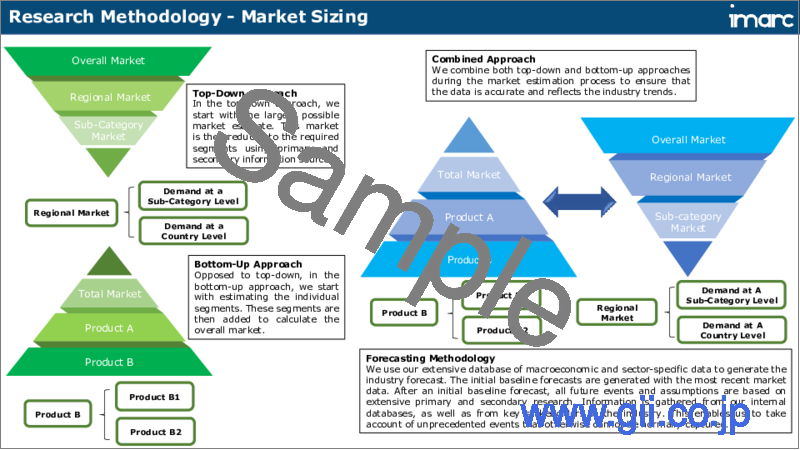|
|
市場調査レポート
商品コード
1467670
建築用内装塗料の市場レポート:樹脂タイプ、技術、流通チャネル、消費者タイプ、最終用途分野、地域別、2024~2032年Interior Architectural Coatings Market Report by Resin Type, Technology, Distribution Channel, Type of Consumer, End Use Sector, and Region 2024-2032 |
||||||
カスタマイズ可能
|
|||||||
| 建築用内装塗料の市場レポート:樹脂タイプ、技術、流通チャネル、消費者タイプ、最終用途分野、地域別、2024~2032年 |
|
出版日: 2024年04月08日
発行: IMARC
ページ情報: 英文 135 Pages
納期: 2~3営業日
|
- 全表示
- 概要
- 図表
- 目次
世界の建築用内装塗料市場規模は2023年に485億米ドルに達しました。今後、IMARC Groupは、2024~2032年にかけて3.6%の成長率(CAGR)を示し、2032年には672億米ドルに達すると予測しています。
建築用内装には、仕上げ、配管、照明、材料、電気的要件、利用可能なスペースのスマートな使用など、建築のいくつかの側面を考慮しながら、技術的・科学的に建物の内部空間を管理することが含まれます。建築用塗料は一般的に有機的な仕上げで構成され、建築物の内部表面を美化・保護するために使用されます。選択時に消費者が求めるのは、隠ぺい力、塗りやすさ、流動性、レベリング性、低揮発性有機化合物(VOC)排出量、有害物質からの保護、防汚性、環境への配慮、低臭気など、さまざまな美的・性能的特性や特徴です。現在市場では、ワニス、シーラー、壁用塗料、プライマー、セラミックなど、さまざまな種類の塗料が販売されています。
ここ数年、商業・住宅両部門で建設活動が活発化しており、これが市場の成長を後押ししています。また、世界中の消費者が、住宅に適切な美観と保護を提供できる最高品質の塗料が入手可能であることを認識するようになりました。その他の要因としては、多くの新興国が現在転換期を迎えており、それに伴ってインフラ活動が活発化し、内装建築用の改良型塗料に対する需要が高まっていることが挙げられます。さらに、環境悪化に対する懸念の高まりから、メーカー各社は持続可能性が高く、環境に優しい保護を提供する塗料剤の製造に取り組んでいます。
本レポートで扱う主要質問
- 建築用内装塗料の世界市場はこれまでどのように推移してきたか?
- 主要な地域市場は?
- COVID-19が世界の建築用内装塗料市場に与えた影響は?
- 市場における主要樹脂タイプは?
- 市場における主要技術は?
- 市場の主要流通チャネルは?
- 消費者タイプ別の市場内訳は?
- 市場の主要最終用途分野は?
- 世界の建築用内装塗料産業のバリューチェーンにおける様々な段階とは?
- 世界の建築用内装塗料剤産業の主要促進要因と課題は何か?
- 世界の室内装飾用塗料産業の構造と主要参入企業は?
- 世界の室内装飾用塗料業界における競合の程度は?
- 室内装飾用塗料はどのように製造されているのか?
目次
第1章 序文
第2章 調査範囲と調査手法
- 調査目的
- 利害関係者
- データソース
- 一次情報
- 二次情報
- 市場推定
- ボトムアップアプローチ
- トップダウンアプローチ
- 調査手法
第3章 エグゼクティブサマリー
第4章 イントロダクション
- 概要
- 主要産業動向
第5章 建築用内装塗料の世界市場
- 市場概要
- 市場実績
- COVID-19の影響
- 市場内訳:樹脂タイプ別
- 市場内訳:技術別
- 市場内訳:流通チャネル別
- 市場内訳:消費者タイプ別
- 市場内訳:最終用途分野別
- 市場内訳:地域別
- 市場予測
- SWOT分析
- 概要
- 強み
- 弱み
- 機会
- 脅威
- バリューチェーン分析
- ポーターのファイブフォース分析
- 概要
- 買い手の交渉力
- 供給企業の交渉力
- 競合の程度
- 新規参入業者の脅威
- 代替品の脅威
- 価格分析
- 主要価格指標
- 価格構造
- マージン分析
第6章 市場内訳:樹脂タイプ別
- アクリル
- ポリエステル
- アルキド
- エポキシ
- ポリウレタン
- その他
第7章 市場内訳:技術別
- 水性塗料
- 溶剤型塗料剤
第8章 市場内訳:流通チャネル別
- 直営店
- 独立系ディストリビューター
- 大手小売・卸
第9章 市場内訳:消費者タイプ別
- プロフェッショナル消費者
- DIY消費者
第10章 市場内訳:最終用途分野別
- 住宅
- 非住宅
第11章 市場内訳:地域別
- アジア太平洋
- 欧州
- 北米
- 中東・アフリカ
- ラテンアメリカ
第12章 建築用内装塗料の製造工程
- 製品概要
- 原材料の要件
- 製造プロセス
- 主要成功要因とリスク要因
第13章 競合情勢
- 市場構造
- 主要企業
- 主要企業のプロファイル
- Akzo Nobel N.V.
- Axalta Coatings Systems, LLC
- Asian Paints Limited
- BASF SE
- Nippon Paint/Nipsea Group
- Kansai Paint Co. Ltd.
- PPG Industries Inc.
- RPM International Inc.
- The Sherwin-Williams Company
- The Valspar Corporation
List of Figures
- Figure 1: Global: Interior Architectural Coatings Market: Major Drivers and Challenges
- Figure 2: Global: Interior Architectural Coatings Market: Sales Value (in Billion US$), 2018-2023
- Figure 3: Global: Interior Architectural Coatings Market: Breakup by Resin Type (in %), 2023
- Figure 4: Global: Interior Architectural Coatings Market: Breakup by Technology (in %), 2023
- Figure 5: Global: Interior Architectural Coatings Market: Breakup by Distribution Channel (in %), 2023
- Figure 6: Global: Interior Architectural Coatings Market: Breakup by Type of Consumer (in %), 2023
- Figure 7: Global: Interior Architectural Coatings Market: Breakup by End-Use Sector (in %), 2023
- Figure 8: Global: Interior Architectural Coatings Market: Breakup by Region (in %), 2023
- Figure 9: Global: Interior Architectural Coatings Market Forecast: Sales Value (in Billion US$), 2024-2032
- Figure 10: Global: Interior Architectural Coatings Industry: SWOT Analysis
- Figure 11: Global: Interior Architectural Coatings Industry: Value Chain Analysis
- Figure 12: Global: Interior Architectural Coatings Industry: Porter's Five Forces Analysis
- Figure 13: Global: Interior Architectural Coatings (Acrylic) Market: Sales Value (in Million US$), 2018 & 2023
- Figure 14: Global: Interior Architectural Coatings (Acrylic) Market Forecast: Sales Value (in Million US$), 2024-2032
- Figure 15: Global: Interior Architectural Coatings (Polyester) Market: Sales Value (in Million US$), 2018 & 2023
- Figure 16: Global: Interior Architectural Coatings (Polyester) Market Forecast: Sales Value (in Million US$), 2024-2032
- Figure 17: Global: Interior Architectural Coatings (Alkyd) Market: Sales Value (in Million US$), 2018 & 2023
- Figure 18: Global: Interior Architectural Coatings (Alkyd) Market Forecast: Sales Value (in Million US$), 2024-2032
- Figure 19: Global: Interior Architectural Coatings (Epoxy) Market: Sales Value (in Million US$), 2018 & 2023
- Figure 20: Global: Interior Architectural Coatings (Epoxy) Market Forecast: Sales Value (in Million US$), 2024-2032
- Figure 21: Global: Interior Architectural Coatings (Polyurethane) Market: Sales Value (in Million US$), 2018 & 2023
- Figure 22: Global: Interior Architectural Coatings (Polyurethane) Market Forecast: Sales Value (in Million US$), 2024-2032
- Figure 23: Global: Interior Architectural Coatings (Other Types) Market: Sales Value (in Million US$), 2018 & 2023
- Figure 24: Global: Interior Architectural Coatings (Other Types) Market Forecast: Sales Value (in Million US$), 2024-2032
- Figure 25: Global: Interior Architectural Coatings (Water-Borne Coatings) Market: Sales Value (in Million US$), 2018 & 2023
- Figure 26: Global: Interior Architectural Coatings (Water-Borne Coatings) Market Forecast: Sales Value (in Million US$), 2024-2032
- Figure 27: Global: Interior Architectural Coatings (Solvent-Borne Coatings) Market: Sales Value (in Million US$), 2018 & 2023
- Figure 28: Global: Interior Architectural Coatings (Solvent-Borne Coatings) Market Forecast: Sales Value (in Million US$), 2024-2032
- Figure 29: Global: Interior Architectural Coatings Market: Sales through Company-Owned Stores (in Million US$), 2018 & 2023
- Figure 30: Global: Interior Architectural Coatings Market Forecast: Sales through Company-Owned Stores (in Million US$), 2024-2032
- Figure 31: Global: Interior Architectural Coatings Market: Sales through Independent Distributors (in Million US$), 2018 & 2023
- Figure 32: Global: Interior Architectural Coatings Market Forecast: Sales through Independent Distributors (in Million US$), 2024-2032
- Figure 33: Global: Interior Architectural Coatings Market: Sales through Large Retailers and Wholesalers (in Million US$), 2018 & 2023
- Figure 34: Global: Interior Architectural Coatings Market Forecast: Sales through Large Retailers and Wholesalers (in Million US$), 2024-2032
- Figure 35: Global: Interior Architectural Coatings (Professional Consumers) Market: Sales Value (in Million US$), 2018 & 2023
- Figure 36: Global: Interior Architectural Coatings (Professional Consumers) Market Forecast: Sales Value (in Million US$), 2024-2032
- Figure 37: Global: Interior Architectural Coatings (DIY Consumers) Market: Sales Value (in Million US$), 2018 & 2023
- Figure 38: Global: Interior Architectural Coatings (DIY Consumers) Market Forecast: Sales Value (in Million US$), 2024-2032
- Figure 39: Global: Interior Architectural Coatings (Residential Sector) Market: Sales Value (in Million US$), 2018 & 2023
- Figure 40: Global: Interior Architectural Coatings (Residential Sector) Market Forecast: Sales Value (in Million US$), 2024-2032
- Figure 41: Global: Interior Architectural Coatings (Non-Residential Sector) Market: Sales Value (in Million US$), 2018 & 2023
- Figure 42: Global: Interior Architectural Coatings (Non-Residential Sector) Market Forecast: Sales Value (in Million US$), 2024-2032
- Figure 43: Asia Pacific: Interior Architectural Coatings Market: Sales Value (in Million US$), 2018 & 2023
- Figure 44: Asia Pacific: Interior Architectural Coatings Market Forecast: Sales Value (in Million US$), 2024-2032
- Figure 45: Europe: Interior Architectural Coatings Market: Sales Value (in Million US$), 2018 & 2023
- Figure 46: Europe: Interior Architectural Coatings Market Forecast: Sales Value (in Million US$), 2024-2032
- Figure 47: North America: Interior Architectural Coatings Market: Sales Value (in Million US$), 2018 & 2023
- Figure 48: North America: Interior Architectural Coatings Market Forecast: Sales Value (in Million US$), 2024-2032
- Figure 49: Middle East and Africa: Interior Architectural Coatings Market: Sales Value (in Million US$), 2018 & 2023
- Figure 50: Middle East and Africa: Interior Architectural Coatings Market Forecast: Sales Value (in Million US$), 2024-2032
- Figure 51: Latin America: Interior Architectural Coatings Market: Sales Value (in Million US$), 2018 & 2023
- Figure 52: Latin America: Interior Architectural Coatings Market Forecast: Sales Value (in Million US$), 2024-2032
- Figure 53: Interior Architectural Coatings Manufacturing: Detailed Process Flow
List of Tables
- Table 1: Global: Interior Architectural Coatings Market: Key Industry Highlights, 2023 and 2032
- Table 2: Global: Interior Architectural Coatings Market Forecast: Breakup by Resin Type (in Million US$), 2024-2032
- Table 3: Global: Interior Architectural Coatings Market Forecast: Breakup by Technology (in Million US$), 2024-2032
- Table 4: Global: Interior Architectural Coatings Market Forecast: Breakup by Distribution Channel (in Million US$), 2024-2032
- Table 5: Global: Interior Architectural Coatings Market Forecast: Breakup by Type of Consumer (in Million US$), 2024-2032
- Table 6: Global: Interior Architectural Coatings Market Forecast: Breakup by End-Use Sector (in Million US$), 2024-2032
- Table 7: Global: Interior Architectural Coatings Market Forecast: Breakup by Region (in Million US$), 2024-2032
- Table 8: Interior Architectural Coatings Manufacturing: Raw Material Requirements
- Table 9: Global: Interior Architectural Coatings Market: Competitive Structure
- Table 10: Global: Interior Architectural Coatings Market: Key Players
The global interior architectural coatings market size reached US$ 48.5 Billion in 2023. Looking forward, IMARC Group expects the market to reach US$ 67.2 Billion by 2032, exhibiting a growth rate (CAGR) of 3.6% during 2024-2032.
Interior architecture includes technically and scientifically managing the interior space of a building while considering several construction aspects, such as finishes, plumbing, lighting, materials, electrical requirements, and smart use of the available space. Architectural coatings typically consist of organic finishes, which are used for beautifying and protecting the interior surfaces of the building. At the time of selection, consumers look for various aesthetic and performance properties and characteristics, including hiding power, ease of application, flow and leveling, low volatile organic compound (VOC) emissions, user protection from toxins, stain resistance, environment friendliness, and low odor. Presently, there are different types of coatings available in the market, which consist of items like varnishes, sealers, wall paints, primers, ceramics and among others.
Over the past few years, both the commercial and residential sectors have witnessed a rise in construction activities, which is impelling the growth of the market. Also, consumers across the globe have become aware of the availability of premium quality coatings that can provide appropriate beautification and protection to their houses. Other than this, many emerging economies are currently going through a transition, which has led to a rise in infrastructural activities with the escalating demand for improved coatings for interior architecture. Moreover, rising concerns regarding environmental degradation have prompted manufacturers to produce coatings that are highly sustainable and offer eco-friendly protection.
Key Market Segmentation:
IMARC Group provides an analysis of the key trends in each sub-segment of the global interior architectural coatings market report, along with forecasts at the global and regional level from 2024-2032. Our report has categorized the market based on resin type, technology, distribution channel, type of consumer and end use sector.
Breakup by Resin Type:
Acrylic
Polyester
Alkyd
Epoxy
Polyurethane
Others
Acrylic resins are most commonly used for producing interior coatings. They offer better water resistance, adhesion, resistance to alkali cleaners, stain protection, and resistance to cracking and blistering.
Breakup by Technology:
Water-Borne Coatings
Solvent-Borne Coatings
Currently, water-borne coatings technology is most widely utilized in the industry owing to the rising demand for environmentally sustainable and high-performing coatings.
Breakup by Distribution Channel:
Company-Owned Stores
Independent Distributors
Large Retailers and Wholesalers
Amongst these, company-owned stores are the largest distribution channel.
Breakup by Type of Consumer:
Professional Consumers
DIY Consumers
At present, professional consumers exhibit dominance in the market.
Breakup by End Use Sector:
Residential
Non-Residential
Presently, most of the coatings are used in the residential sector.
Breakup by Region:
Asia Pacific
Europe
North America
Middle East and Africa
Latin America
On the geographical front, Asia Pacific is the biggest market, holding the majority of the share. The growth can be attributed to the rapid development of rail and road infrastructure and rising construction activities in China, along with increasing investments in overseas infrastructure projects in Japan.
Competitive Landscape:
The competitive landscape of the market has also been examined with some of the key players being Akzo Nobel N.V., Axalta Coatings Systems, LLC, Asian Paints Limited, BASF SE, Nippon Paint/ Nipsea Group, Kansai Paint Co. Ltd., PPG Industries, Inc., RPM International Inc., The Sherwin-Williams Company, and The Valspar Corporation.
Key Questions Answered in This Report:
- How has the global interior architectural coatings market performed so far and how will it perform in the coming years?
- What are the key regional markets?
- What has been the impact of COVID-19 on the global interior architectural coatings market?
- What are the major resin types in the market?
- What are the key technologies in the market?
- What are the major distribution channels in the market?
- What is the breakup of the market on the basis of consumer type?
- What are the major end-use segments in the market?
- What are the various stages in the value chain of the global interior architectural coatings industry?
- What are the key driving factors and challenges in the global interior architectural coatings industry?
- What is the structure of the global interior architectural coatings industry and who are the key players?
- What is the degree of competition in the global interior architectural coatings industry?
- How are interior architectural coatings manufactured?
Table of Contents
1 Preface
2 Scope and Methodology
- 2.1 Objectives of the Study
- 2.2 Stakeholders
- 2.3 Data Sources
- 2.3.1 Primary Sources
- 2.3.2 Secondary Sources
- 2.4 Market Estimation
- 2.4.1 Bottom-Up Approach
- 2.4.2 Top-Down Approach
- 2.5 Forecasting Methodology
3 Executive Summary
4 Introduction
- 4.1 Overview
- 4.2 Key Industry Trends
5 Global Interior Architectural Coatings Market
- 5.1 Market Overview
- 5.2 Market Performance
- 5.3 Impact of COVID-19
- 5.4 Market Breakup by Resin Type
- 5.5 Market Breakup by Technology
- 5.6 Market Breakup by Distribution Channel
- 5.7 Market Breakup by Type of Consumer
- 5.8 Market Breakup by End-Use Sector
- 5.9 Market Breakup by Region
- 5.10 Market Forecast
- 5.11 SWOT Analysis
- 5.11.1 Overview
- 5.11.2 Strengths
- 5.11.3 Weaknesses
- 5.11.4 Opportunities
- 5.11.5 Threats
- 5.12 Value Chain Analysis
- 5.13 Porters Five Forces Analysis
- 5.13.1 Overview
- 5.13.2 Bargaining Power of Buyers
- 5.13.3 Bargaining Power of Suppliers
- 5.13.4 Degree of Competition
- 5.13.5 Threat of New Entrants
- 5.13.6 Threat of Substitutes
- 5.14 Price Analysis
- 5.14.1 Key Price Indicators
- 5.14.2 Price Structure
- 5.14.3 Margin Analysis
6 Market Breakup by Resin Type
- 6.1 Acrylic
- 6.1.1 Market Trends
- 6.1.2 Market Forecast
- 6.2 Polyester
- 6.2.1 Market Trends
- 6.2.2 Market Forecast
- 6.3 Alkyd
- 6.3.1 Market Trends
- 6.3.2 Market Forecast
- 6.4 Epoxy
- 6.4.1 Market Trends
- 6.4.2 Market Forecast
- 6.5 Polyurethane
- 6.5.1 Market Trends
- 6.5.2 Market Forecast
- 6.6 Others
- 6.6.1 Market Trends
- 6.6.2 Market Forecast
7 Market Breakup by Technology
- 7.1 Water-Borne Coatings
- 7.1.1 Market Trends
- 7.1.2 Market Forecast
- 7.2 Solvent-Borne Coatings
- 7.2.1 Market Trends
- 7.2.2 Market Forecast
8 Market Breakup by Distribution Channel
- 8.1 Company-Owned Stores
- 8.1.1 Market Trends
- 8.1.2 Market Forecast
- 8.2 Independent Distributors
- 8.2.1 Market Trends
- 8.2.2 Market Forecast
- 8.3 Large Retailers and Wholesalers
- 8.3.1 Market Trends
- 8.3.2 Market Forecast
9 Market Breakup by Type of Consumer
- 9.1 Professional Consumers
- 9.1.1 Market Trends
- 9.1.2 Market Forecast
- 9.2 DIY Consumers
- 9.2.1 Market Trends
- 9.2.2 Market Forecast
10 Market Breakup by End-Use Sector
- 10.1 Residential
- 10.1.1 Market Trends
- 10.1.2 Market Forecast
- 10.2 Non-Residential
- 10.2.1 Market Trends
- 10.2.2 Market Forecast
11 Market Breakup by Region
- 11.1 Asia Pacific
- 11.1.1 Market Trends
- 11.1.2 Market Forecast
- 11.2 Europe
- 11.2.1 Market Trends
- 11.2.2 Market Forecast
- 11.3 North America
- 11.3.1 Market Trends
- 11.3.2 Market Forecast
- 11.4 Middle East and Africa
- 11.4.1 Market Trends
- 11.4.2 Market Forecast
- 11.5 Latin America
- 11.5.1 Market Trends
- 11.5.2 Market Forecast
12 Interior Architectural Coatings Manufacturing Process
- 12.1 Product Overview
- 12.2 Raw Material Requirements
- 12.3 Manufacturing Process
- 12.4 Key Success and Risk Factors
13 Competitive Landscape
- 13.1 Market Structure
- 13.2 Key Players
- 13.3 Profiles of Key Players
- 13.3.1 Akzo Nobel N.V.
- 13.3.2 Axalta Coatings Systems, LLC
- 13.3.3 Asian Paints Limited
- 13.3.4 BASF SE
- 13.3.5 Nippon Paint/Nipsea Group
- 13.3.6 Kansai Paint Co. Ltd.
- 13.3.7 PPG Industries Inc.
- 13.3.8 RPM International Inc.
- 13.3.9 The Sherwin-Williams Company
- 13.3.10 The Valspar Corporation





